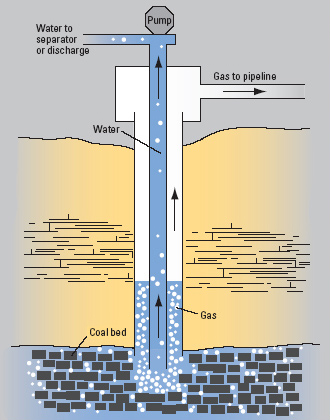Q. What is Coalbed methane (CBM)? Discuss the challenges associated with the extraction of methane gas from this source. (150 words)
24 Jun, 2020 GS Paper 3 EconomyApproach
- In the introduction briefly define Coalbed methane and highlight its econmic importance.
- Discuss the challenges in various dimensions like environmental concerns, technical difficulties etc
- Conclude by summarising your answer and suggesting some measures to overcome these challenges.
Introduction
Coal bed methane (CBM) is a form of natural gas which can be recovered from coal deposits. It is an important unconventional gas occurring naturally in coal beds, and is increasingly being used for industrial and utility purposes. Especially in industries such as in cement, rolling mills, steel plants, and methanol production. In recent decades it has become an important source of energy in the United States, Canada, Australia, and other countries. India has fifth-largest proven coal reserves in the world.
Body
Process of Extraction
- A steel-cased hole is drilled into the coal seam and the underground (produced) water is pumped out through tubing.
- Removal of produced water helps reduce the hydrostatic pressure within the coal bed, causing the gas to be desorbed from its surface.
- As production occurs, the change in pressure alters the porosity and permeability of the coal bed.
- The recovered gas is sent into a natural gas pipeline or air compressor system.
Challenges in Extraction of CBM
- Viability issues: Assessing the economic cost and environment risk impact factors makes CBM a comparatively less attractive energy source option.
- Coalbed methane wells often produce at lower gas rates than conventional reservoirs, typically before CBM production peaks, it can have large initial costs.
- Risk of increasing greenhouse emission: In extraction of CBM there is risk of large amounts of methane escaping into the atmosphere. Hence, it may contribute to increasing global warming.
- Global methane emissions from coal mines are projected to account for a significant amount of total global methane emissions.
- Methane is rated as having 72 times the effect on global warming per unit of mass than CO2.
- Even burning of coalbed methane releases carbon dioxide (CO2) into the atmosphere.
- Pollution by produced water The produced saline water brought to the surface as a byproduct of gas extraction varies greatly in quality from area to area.
- It may contain undesirable concentrations of dissolved substances such as salts, naturally present chemicals, heavy metals and radionuclides which may pollute the soil and sources of water nearby.
- Depletion of groundwater: Water withdrawal for CBM extraction may depress aquifers over a large area and deplete groundwater resources.
- For example, in Australia, it is estimated that in CBM production 126,000 million litres of groundwater is extracted per year.
- Greater accident potentials: As the depth of CBM exploitation increases, it increases the concentration of extraction interrelated risks to persons and property.
- There is great risk of ignition and methane explosion threatening lives and property around the mining area.
Conclusion
Thus, Methane from CBM is an environmentally safe and clean gas. It would help in increasing the domestic gas production and reduce greenhouse gas emissions. But measures like environmental impact assessment and cost benefit analysis should be adopted and implemented carefully before looking at CBM as alternative fuel in the long run.
